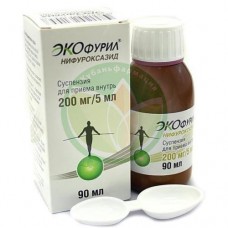Expiration date: 06/2026
Composition
5 ml of suspension contains:
Active ingredient: nifuroxazide 200.00 mg,
excipients: maltitol - 350.00 mg, lactulose - 300.00 mg, povidone K-90 - 25.00 mg, xanthan gum - 20.00 mg, banana flavor - 10.00 mg, methyl parahydroxybenzoate - 5.00 mg, sodium citrate dihydrate 0.015 mg, citric acid anhydrous - 0.001 mg, purified water - until a suspension of 5.0 ml is obtained.
Dosage form
suspension for oral administration
Description
Homogeneous suspension of yellow color, with a characteristic odor.
Pharmacodynamics
Antimicrobial agent, a derivative of nitrofuran.
It blocks the activity of dehydrogenases and inhibits respiratory chains, the tricarboxylic acid cycle and a number of other biochemical processes in the microbial cell. Destroys the membrane of the microbial cell, reduces the production of toxins by microorganisms.
It is highly active against Campilobacter jejuni, Escherichia coli, Salmonella spp., Shigella spp., Clostridium perfringens, Vibrio cholerae pathogenic Vibrions and Vibrio parahaemolyticus, Staphylococcus spp.
Weakly sensitive to nifuroxazide: Citrobacter spp., Enterobacter cloacae and Proteus indologens.
Resistant to nifuroxazide: Klebsiella spp., Proteus mirabilis, Providencia spp., Pseudomonas spp.
It does not disturb the balance of the intestinal microflora.
In acute bacterial diarrhea, it restores intestinal eubiosis.
When infected with enterotropic viruses, it prevents the development of bacterial superinfection.
Pharmacokinetics
After oral administration, nifuroxazide is practically not absorbed from the digestive tract and has its antibacterial effect exclusively in the intestinal lumen. Nifuroxazide is excreted by the intestine: 20% unchanged, and the remaining amount of nifuroxazide is chemically altered.
Indications for use
Acute bacterial diarrhea, occurring without deterioration of the general condition, increase in body temperature, intoxication.
Contraindications
- Hypersensitivity to nifuroxazide, to nitrofuran derivatives, and other components of the drug,
- pregnancy,
- newborn period (up to 1 month), prematurity.
Use during pregnancy and lactation
The use of the drug during pregnancy is contraindicated.
During breastfeeding, it is necessary to consult a doctor before using the drug.
Side effects
Allergic reactions (skin rash, urticaria, Quincke's edema, anaphylactic shock).
If any of the side effects listed in the instructions worsen, or you notice any other side effects not listed in the instructions, inform your doctor.
Interaction
Simultaneous use with drugs that cause the development of disulfiram-like reactions or inhibit the function of the central nervous system is not recommended.
If you are taking other medications (including over-the-counter ones), consult your doctor before using nifuroxazide.
Method of administration and dosage
Inside.
A double-sided measuring spoon is used for dosing, with a volume of 2.5 ml on one side and 5 ml on the other side. Before use, the suspension must be shaken well.
For children aged 1-6 months: 2.5 ml 2 or 3 times a day (with an interval of 8-12 hours).
For children aged 6 months to 3 years: 2.5 ml 3 times a day (the interval between doses is 8 hours).
For children aged 3 to 6 years: 5 ml 3 times a day (the interval between doses is 8 hours).
Children from 6 to 18 years old: 5 ml 3-4 times a day (the interval between doses is 6-8 hours).
Adults: 5 ml 4 times a day (the interval between doses is 6 hours).
The duration of the course of treatment is 5-7 days, but not more than 7 days.
If there is no improvement during the first three days, then you should consult a doctor.
The drug should be used according to the method of application and in the doses specified in the instructions.
If necessary, consult a doctor before using the drug.
Overdose
The symptoms of overdose are not known.
The treatment is symptomatic.
Special instructions
In the treatment of diarrhea, rehydration therapy should be performed simultaneously with nifuroxazide therapy.
Treatment of diarrhea in children under 3 years of age should be carried out under the supervision of a doctor.
In the case of bacterial diarrhea with signs of systemic damage (deterioration of the general condition, fever, symptoms of intoxication or infection), you should consult a doctor to resolve questions about the use of systemic antibacterial drugs.
If symptoms of a hypersensitivity reaction appear (skin rash and itching, difficulty breathing, shortness of breath), the drug should be discontinued.
Due to the content of methyl parahydroxybenzoate, the drug may cause allergic reactions (possibly delayed).
Alcohol consumption during nifuroxazide therapy is prohibited.
Influence on the ability to drive vehicles and manage mechanisms
The drug does not have a negative effect on the ability to drive vehicles and/or other mechanisms.
Release form
Oral suspension, 200 mg / 5 ml.
Packaging
90 ml each in a 100 ml dark glass bottle with a screw-on plastic lid.
Each bottle, together with a double-sided dosage spoon (small capacity 2.5 ml, large - 5 ml) and instructions for use, is placed in a pack of cardboard.
Conditions of release from pharmacies
Without a prescription
Storage conditions
In a place protected from light, at a temperature not exceeding 25 C. Do not freeze.
The opened bottle should not be stored for more than 7 days.
Keep out of reach of children.
Expiration date
2 years. Do not use after the expiration date.



